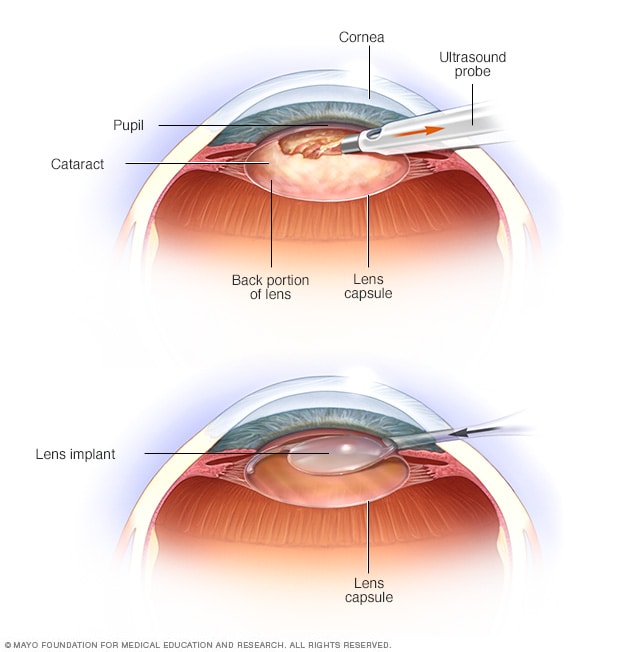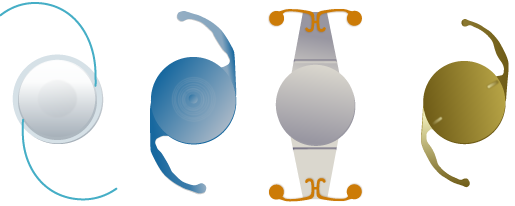What was entailed in my cataract surgery?
In a typical cataract surgery, a round hole is made at the top of your lens capsule, which is the container in which the lens sits. (Your lens is what helps focus light onto your retina, and the cataract inside it is what's preventing that from happening for me.)The lens is then broken up using sonication and sucked out through the hole.
Afterwards, a new, artificial lens is inserted.
 |
| Lens implant size, for reference |
 |
| Cataract surgery, at a high level |
 |
| Some common intraocular lens implant designs |
Types of lens implants
I'm sure I'm oversimplifying this a bit, but the eye is a sophisticated organ and your lens is what allows you to change the location / distance at which you are focusing. A healthy eye with a natural lens can focus on something miles away, or a foot in front of your face, and anywhere in between. (If you need correction, you may not be able to do this perfectly at all distances, but with glasses or contact lenses, you can.)Once your natural lens has been removed, you no longer have the luxury of being able to focus continuously at any point along a range of distances. You do, however, have a few choices to make as to how this will be mitigated.
There are two types of lens implants: monofocal and multifocal.
- Monofocal lenses allow you to focus at a single distance, and you get to choose this distance, but may want or need correction for seeing at other distances.
- Multifocal lenses allow you to focus at 3 distances, but still do not provide perfect vision. Patients often suffer from glare at night. And importantly, they must be placed perfectly to function properly.
I was advised by both Dr. Shields and the doctors in Denmark against the multifocal path due to the complexity of my case.
So I received a monofocal lens implant. I was near-sighted in both eyes before all of this: -4.50 in my left eye and -4.00 in my right (at least, those are my contact lens prescriptions). The surgeons performed detailed measurements before the surgery to determine lens implant size and strength. The goal was to correct my left eye to ~-3.00. What this means:
- I would likely be able to read without correction using my left eye
- I would be able to correct my left eye if desired, but if so would not be able to read with it
Bottom line: my hoped-for long-term state is to keep my left eye un-corrected and be able to use it for reading, but otherwise rely on my [corrected] right eye for distance vision. This is apparently a state that many can achieve :)
What was special about my surgery?
Obviously, my cataract surgery is not perfectly typical.- I'm 32; most patients with cataracts have milder ones that naturally occur with age, and elect to have surgery anywhere from their 60s to 90s. My chosen implant strength and type will affect me for longer; I have longer to use them :)
- My cataract is very dense, and is actually hard; it has caused higher-than-usual pressure in my eye, even for someone with a cataract.
- My lens capsule is slightly weakened and fragile.
All of this is of course due to the fact that radiation is the cause for my having a cataract in the first place. So from my first visit to Rigshospitalet, I was seen by a specialist in eye cancer. The surgeon that then performed my surgery was an expert, selected for my case because of the rare fragility of my eye. And the health and state of my lens capsule was examined quite closely leading up to my surgery.
But in case this has you stressed out, don't worry; while dry and fragile, my lens was smooth and not wrinkled, which I was told was a good thing :)
How did it go?
In short: well!
It was very weird though. I arrived and was given numbing and dilating drops immediately. I was offered a low dose of anti-anxiety meds, to which I said yes please. Spoiler alert: they did not help at all.
After over a half hour of waiting, I was greeted by my surgeon and handed a hair cap, then walked into the OR. I sat on ha chair and was given a pillow for under my legs, and the chair was tilted back. The room was very cold. They confirmed with me that my left eye was to be operated upon, then marked it with a pen.
The area around my eye was cleaned, then my face was draped leaving only my left eye exposed. I was asked to look directly into a very bright light and became worried that I wouldn't be able to keep my eye still, but they reassured me and we proceeded.
The whole thing took about 10 minutes. I looked into the light for about 7 minutes (yes, I counted). Around 7-8 minutes in, I felt vague pressure against my eye area. Then a machine turned on; I gathered that the incision had been made and my lens was being broken apart and sucked out. I was right, because about 30 seconds later, the world I could see became much clearer. Then I could detect the implant was being added, and it looked kind of shiny; I could detect light refracting off of what seemed like tightly-coiled semicircles at the 4 points of the compass as it was inserted in. When asked if things seemed better, I answered in the affirmative.
About 2 minutes later, I was done. The draping was being removed and I was raised back to a sitting position.
Before I left, the surgeon let me know that when he first cut into my lens capsule, it tore linearly; this isn't ideal, as the hole is supposed to be circular. This likely happened because of the fragile, radiation-induced state of my lens capsule. But he said he was able to recover it and make a round hole, and perform the procedure. He also said that I have a secondary cataract on the rear of my lens capsule; they'll want to monitor it for 3 months, but after that will likely be able to remove it using a laser (no surgery/incisions needed).
After that, I walked into the waiting room, claimed my jacket, and went home! At this point the vision in my left eye was still quite poor, but much better than before the surgery.
Once outside in the cold, my eye seemed to get a bit cloudier, and this continued until we arrived home, where it felt distinctly worse than right after the surgery. This, however, is expected, so I wasn't too worried.
On the way home, I began to feel sore; I imagine the numbing drops were wearing off. I felt soreness in my eye but no pain; by the time I got home, I had a headache. I slept for 4-6 hours, and the headache wore off gradually after I awoke.
TL;DR: it went well and my vision is much improved
No comments:
Post a Comment